MyDay Portal
1 like90 views
Presentation delivered by Jason Quinn, Assistant Principal: Planning and Infomatics, New College Lanarkshire at the CDN MIS Network event on 21st November, 2019.
1 of 15
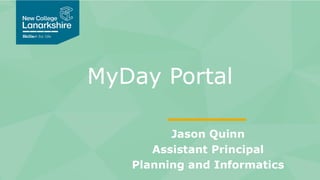


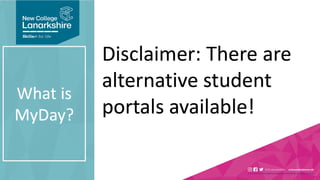

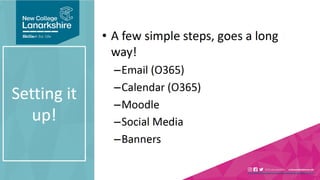
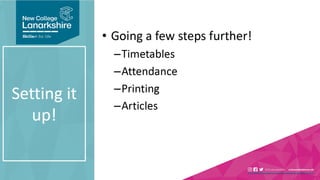

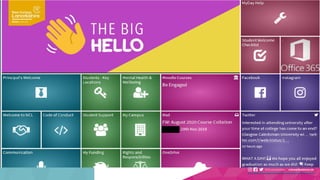
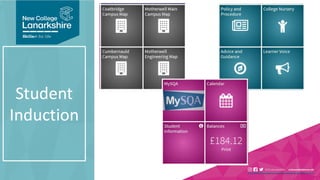

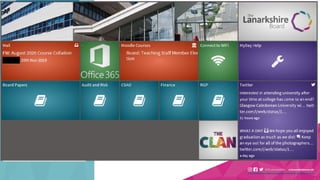
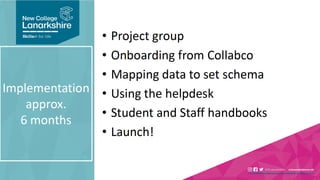
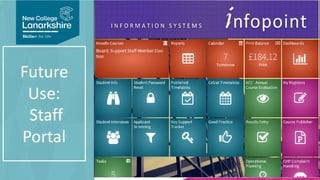

Ad
Recommended
Virtual Bridge Sessions: Making Delivery Online Work for Everyone
Virtual Bridge Sessions: Making Delivery Online Work for EveryoneCollege Development Network
╠²
The document outlines strategies for making online learning experiences accessible to everyone, emphasizing the importance of addressing barriers created by society, as per the social model of disability. It cites legal requirements such as the Equality Act 2010 and provides practical tips for hosting accessible online sessions, including etiquette, resources, and tools for assistance. The focus is on inclusivity, encouraging dialogue with participants about their accessibility needs and providing various formats for content delivery.Scottish Moodle User Group (SMUG): Blackboard Ally & Moodle
Scottish Moodle User Group (SMUG): Blackboard Ally & MoodleCollege Development Network
╠²
The document outlines the benefits of Blackboard Ally in creating accessible content tailored for diverse learners, originally designed to support students with special needs. It highlights a structured approach that includes alternative formats, instructor feedback, and institutional reporting to enhance content accessibility and improve the overall learning environment. Furthermore, the document invites inquiries and provides resources for more information on the implementation of Blackboard Ally.Scottish Moodle User Group (SMUG): Blackboard Ally & Moodle
Scottish Moodle User Group (SMUG): Blackboard Ally & MoodleCollege Development Network
╠²
The document discusses the implementation of Blackboard Ally at the University of Glasgow to enhance the accessibility of web content in compliance with accessibility guidelines. It outlines the process and tools used to improve student experiences through better content accessibility, including resource analysis and alternative formats available for students. The findings indicate a positive trend in accessibility scores and user engagement, while emphasizing the importance of a user-friendly approach to enhance overall experience.Virtual Bridge Sessions: Approaches to Learning and Teaching during Remote De...
Virtual Bridge Sessions: Approaches to Learning and Teaching during Remote De...College Development Network
╠²
The document discusses lessons learned from remote learning in Scottish colleges, highlighting successful strategies and challenges faced during this transition. Key findings include the importance of digital infrastructure, learner engagement, and the necessity for improved support and training for staff and students. Recommendations emphasize addressing digital poverty, enhancing teaching skills, and providing adequate resources to facilitate effective remote education.MIS Network Event: Sector Update
MIS Network Event: Sector UpdateCollege Development Network
╠²
The document outlines the agenda and outcomes of the MIS Development Network meeting held on April 28, 2021, covering topics such as sector updates, digital IDs, online enrollment, and deferrals. It includes links to important guidelines and resources regarding EU exit impacts, COVID-19 funding, and college funding allocations, as well as discussions about various sectors in the educational landscape. Key areas of focus for future discussions include residency, online enrollment best practices, and auditing processes affected by COVID-19.MIS Network Event: SFC Update
MIS Network Event: SFC UpdateCollege Development Network
╠²
The document outlines updates to the data collections for the Further Education Statistics (FES) for 2021-22, including revisions on how qualifications and funding sources are classified and reported. It also mentions the addition of new fields related to student status, care settings, and withdrawal reasons, as well as administrative changes and miscellaneous issues affecting data collection. Key updates involve the removal of certain reporting requirements and the introduction of codes to identify specific student groups and funding conditions.Digital ID cards at New College Lanarkshire
Digital ID cards at New College LanarkshireCollege Development Network
╠²
New College Lanarkshire was implementing digital ID cards to replace physical cards for its 12,000 students annually. This was to address issues with producing and distributing plastic cards at the busiest time of year, which cost over ┬Ż1 per card when including materials but not staff time. The college partnered with Yoti to provide a digital ID card option through their app that students could download, reducing the need to carry a physical card. Over 2,000 students utilized the digital ID card app in the first year of implementation, delighting registration staff and being cost neutral compared to physical cards. While some students preferred a physical card, the program was considered a success and will be further trialled.Virtual Bridge Sessions: Hybrid Delivery - Best of Both Worlds
Virtual Bridge Sessions: Hybrid Delivery - Best of Both WorldsCollege Development Network
╠²
This document discusses strategies for effective hybrid delivery of lessons. It begins by outlining some challenges of the hybrid model and assumptions about remote and in-person students. It then provides approaches for designing consistent lesson plans that ensure equity of experience for all students. Tips are provided for preparing the physical space and technology setup. The document gives advice for delivery, such as connecting with students and sharing the lesson plan. Potential experiences of students and lecturers in the hybrid model are also summarized based on research. Overall, the document aims to provide guidance and best practices for implementing high-quality hybrid instruction.Virtual Bridge Sessions: Social Media, Esports and Copyright - Friends or Foes?
Virtual Bridge Sessions: Social Media, Esports and Copyright - Friends or Foes?College Development Network
╠²
The document discusses the implications of copyright in the context of social media and esports, emphasizing the licensing agreements users grant to platforms like Instagram and YouTube when posting content. It highlights the importance of understanding copyright ownership and the rules governing the use of third-party content, including examples and case studies such as Jennifer Lopez's copyright lawsuit. Additionally, it provides guidance on protecting one's own creative works and outlines relevant copyright exceptions.Virtual Bridge Sessions: The National Cyber Security Centre at Your Service
Virtual Bridge Sessions: The National Cyber Security Centre at Your ServiceCollege Development Network
╠²
The National Cyber Security Centre (NCSC) aims to make the UK the safest place to work online by providing practical guidance, responding to incidents, and nurturing cyber security capabilities. They offer various services such as Cyber Essentials certification, incident management advice, and a cyber security toolkit for boards. Additionally, the NCSC provides resources for improving organizational cyber awareness and incident readiness, including weekly threat reports and alerts.Virtual Bridge Sessions: Managing and Supporting Staff Who Are Delivering Rem...
Virtual Bridge Sessions: Managing and Supporting Staff Who Are Delivering Rem...College Development Network
╠²
The document outlines effective strategies for managing and supporting staff in delivering remote learning, emphasizing the importance of interpersonal approaches and effective pedagogy. It discusses the challenges staff face, such as limited experience with remote learning and the need for clear structures and feedback mechanisms. Key recommendations include empowering staff with autonomy, utilizing various learning types, and incorporating regular evaluation and feedback to enhance the learning experience.Virtual Bridge Sessions: Pedagogy Matters
Virtual Bridge Sessions: Pedagogy MattersCollege Development Network
╠²
The document reflects on the challenges and adaptations in education over the past 10 months, highlighting the resilience of both staff and students. It emphasizes that the quality of teaching is more crucial than the delivery method, with research suggesting a need for effective relationships, assessment, and feedback in remote learning. Additionally, it provides resources and support for educators to enhance their online teaching practices.Virtual Bridge Sessions: Key Messages from Research on Blended or Digital Lea...
Virtual Bridge Sessions: Key Messages from Research on Blended or Digital Lea...College Development Network
╠²
This document summarizes research on blended and digital learning. It finds that blended learning can be as effective as traditional learning, though some students may struggle more online. Research shows blended learning develops independence and skills beyond the classroom. However, teaching methods often rely more on lectures than interaction. Strong design, social connection, and teaching quality are keys to student success online. Sources offer further guidance on implementing blended models.Virtual Bridge Sessions: Messages from international experiences
Virtual Bridge Sessions: Messages from international experiencesCollege Development Network
╠²
The document discusses the significant changes in higher education due to the COVID-19 pandemic, highlighting challenges such as the need for remote learning and support for vulnerable learners. It reflects on lessons learned from various educational institutions, emphasizing the importance of adapting educational delivery models and maintaining student engagement. Furthermore, it outlines strategies for effective leadership and management during the transition to hybrid and online learning environments.Public Sector Accessibility Guidelines: What you need to know (and do!)
Public Sector Accessibility Guidelines: What you need to know (and do!)College Development Network
╠²
The document outlines the Public Sector Accessibility Guidelines, emphasizing compliance for websites and mobile applications, particularly for colleges and universities in the UK. Deadlines for conformity are set for 2019 to 2021, with advice on necessary team composition, accessibility testing, and prioritization of resources. It highlights available support, guidance, and collaborative resources for addressing accessibility challenges.Enhancing Performance through Data-led Decision Making
Enhancing Performance through Data-led Decision MakingCollege Development Network
╠²
The document discusses enhancing performance through data-led decision-making in educational institutions. It emphasizes the importance of addressing challenges, prioritizing actions, and supporting staff and students through digital skills development. Key takeaways include the need for data interpretation in meetings and the critical role of people in the decision-making process.FES Update Summary
FES Update SummaryCollege Development Network
╠²
The document discusses significant issues in matching EMA student records with FES records, particularly for the 2018-19 school year due to data quality problems. It outlines improvements in reporting processes, including an online system for EMA returns and upcoming changes to FES submissions aimed at enhancing data accuracy and supporting fund management. Additionally, it anticipates the removal of separate FES 4 returns, emphasizing the need for improved categorization of college activities by industry standards starting from the 2020-21 academic year.Online Enrolment and ŌĆ£OnboardingŌĆØ
Online Enrolment and ŌĆ£OnboardingŌĆØCollege Development Network
╠²
The document discusses the development of an online enrolment and onboarding system designed to streamline the process for students starting college. The system, based on student feedback, consolidates various enrolment tasks into a single interface and targets students needing assistance. Statistics indicate high completion rates of online enrolment and improved outcomes for bursary students in the 2019/20 academic year.Post-College Destination Data
Post-College Destination DataCollege Development Network
╠²
The document discusses the improvement of data sharing regarding post-college destination outcomes, focusing on understanding student withdrawal reasons and enhancing the 16+ data hub's monthly uploads from colleges. It highlights the need for accurate and comprehensive data to provide better services and support for young people while ensuring effective partnership collaborations. Additionally, it outlines necessary updates to data sharing agreements, reporting methods, and the standard file transfer processes to improve data management.Integrating Interactivity in Content to Match the Pedagogy (and doing it to s...
Integrating Interactivity in Content to Match the Pedagogy (and doing it to s...College Development Network
╠²
This document summarizes a workshop that demonstrates how interactive content libraries like H5P can be fully integrated into Moodle activities at scale. It shows how learning materials developed independently of any delivery platform using semantically rich XML can be automatically produced in Moodle with tight integration. The methodology uses standards-based digital repositories and XML markup to allow single-source content production across multiple formats. Author-developed learning materials focusing on pedagogy can then be automatically delivered through Moodle with a highly functional and integrated experience, while remaining future-proofed against technology changes.Integrating Moodle with University of St Andrews Systems
Integrating Moodle with University of St Andrews SystemsCollege Development Network
╠²
The document discusses the integration of Moodle with the University of St Andrews systems, focusing on the processes involving student records and enrollment. It highlights the use of various systems and databases to facilitate this integration. Additionally, it mentions the specific systems involved, such as mySaint and MMS.Bite-sized CPD: Introduction to Learning Online
Bite-sized CPD: Introduction to Learning OnlineCollege Development Network
╠²
This document summarizes an online course titled "Introduction to Learning Online". The course covered 4 themes: online social presence, digital literacies, assessment for online learning, and affordances of educational media. It included reflective activities and required participation on a minimum of 3-4 separate days, for at least 1 hour 15 minutes total. The conclusions recommend modeling good practice, showcasing available tools, including synchronous learning, and giving choice in contributions to make discussions inclusive.Using MS Teams as an Alternative to Moodle to Help Engage Entry Level College...
Using MS Teams as an Alternative to Moodle to Help Engage Entry Level College...College Development Network
╠²
The document discusses the use of Microsoft Teams as an alternative to Moodle for engaging entry-level college students with social, emotional, or behavioral challenges at Ayrshire College. The approach focuses on innovative, informal communication and resource sharing, resulting in improved student engagement and communication. Future applications include embedding Teams in other programs and exploring its potential in virtual learning environment design.Offline Marking of Practical Exams using OSCEMark
Offline Marking of Practical Exams using OSCEMarkCollege Development Network
╠²
The document discusses the implementation of the Objective Structured Clinical Examination (OSCE) using the oscemark app in veterinary medicine. It outlines a new process for conducting practical exams that streamlines marking and reduces the risk of errors by utilizing Moodle and tablets. The changes have significantly decreased processing time and improved the efficiency of exam administration.Enrolment Method Transition
Enrolment Method TransitionCollege Development Network
╠²
The document outlines the transition of enrolment methods by James Macnee, focusing on moving from an autoenrol cohort method to a more integrated approach using existing Moodle user profiles and cohort data. It highlights problems with the current system, such as patchy unenrolment and lack of support, while suggesting alternatives like database enrolments. The overall goal is to streamline the enrolment process with a more efficient linkage to external cohort databases.Cybersecurity as MIS
Cybersecurity as MISCollege Development Network
╠²
This document discusses how cybersecurity has traditionally been seen as an IT issue rather than a business issue, and how management information systems (MIS) can help bridge the gap between cybersecurity and business operations. The key points made are:
1) Cybersecurity departments collect and analyze large amounts of business data but have struggled to define meaningful metrics and communicate risks to business stakeholders in a way that supports decision-making.
2) MIS understands how to support business decision-making through reporting and can help cybersecurity define key performance indicators that are meaningful to the business rather than just technical metrics.
3) By gaining access to cybersecurity data and integrating cybersecurity elements into existing reporting, MIS can act as a translator betweenSelf Enrolment
Self EnrolmentCollege Development Network
╠²
Presentation delivered by Linda Grant, Edinburgh College at the CDN MIS Network Event on the 1st May, 2019. Part 2 or 2.Online Application and Enrolment @ Edinburgh College
Online Application and Enrolment @ Edinburgh CollegeCollege Development Network
╠²
Presentation delivered by Linda Grant, Edinburgh College at the CDN MIS Network Event on the 1st May, 2019. Part 1 of 2.More Related Content
More from College Development Network (20)
Virtual Bridge Sessions: Social Media, Esports and Copyright - Friends or Foes?
Virtual Bridge Sessions: Social Media, Esports and Copyright - Friends or Foes?College Development Network
╠²
The document discusses the implications of copyright in the context of social media and esports, emphasizing the licensing agreements users grant to platforms like Instagram and YouTube when posting content. It highlights the importance of understanding copyright ownership and the rules governing the use of third-party content, including examples and case studies such as Jennifer Lopez's copyright lawsuit. Additionally, it provides guidance on protecting one's own creative works and outlines relevant copyright exceptions.Virtual Bridge Sessions: The National Cyber Security Centre at Your Service
Virtual Bridge Sessions: The National Cyber Security Centre at Your ServiceCollege Development Network
╠²
The National Cyber Security Centre (NCSC) aims to make the UK the safest place to work online by providing practical guidance, responding to incidents, and nurturing cyber security capabilities. They offer various services such as Cyber Essentials certification, incident management advice, and a cyber security toolkit for boards. Additionally, the NCSC provides resources for improving organizational cyber awareness and incident readiness, including weekly threat reports and alerts.Virtual Bridge Sessions: Managing and Supporting Staff Who Are Delivering Rem...
Virtual Bridge Sessions: Managing and Supporting Staff Who Are Delivering Rem...College Development Network
╠²
The document outlines effective strategies for managing and supporting staff in delivering remote learning, emphasizing the importance of interpersonal approaches and effective pedagogy. It discusses the challenges staff face, such as limited experience with remote learning and the need for clear structures and feedback mechanisms. Key recommendations include empowering staff with autonomy, utilizing various learning types, and incorporating regular evaluation and feedback to enhance the learning experience.Virtual Bridge Sessions: Pedagogy Matters
Virtual Bridge Sessions: Pedagogy MattersCollege Development Network
╠²
The document reflects on the challenges and adaptations in education over the past 10 months, highlighting the resilience of both staff and students. It emphasizes that the quality of teaching is more crucial than the delivery method, with research suggesting a need for effective relationships, assessment, and feedback in remote learning. Additionally, it provides resources and support for educators to enhance their online teaching practices.Virtual Bridge Sessions: Key Messages from Research on Blended or Digital Lea...
Virtual Bridge Sessions: Key Messages from Research on Blended or Digital Lea...College Development Network
╠²
This document summarizes research on blended and digital learning. It finds that blended learning can be as effective as traditional learning, though some students may struggle more online. Research shows blended learning develops independence and skills beyond the classroom. However, teaching methods often rely more on lectures than interaction. Strong design, social connection, and teaching quality are keys to student success online. Sources offer further guidance on implementing blended models.Virtual Bridge Sessions: Messages from international experiences
Virtual Bridge Sessions: Messages from international experiencesCollege Development Network
╠²
The document discusses the significant changes in higher education due to the COVID-19 pandemic, highlighting challenges such as the need for remote learning and support for vulnerable learners. It reflects on lessons learned from various educational institutions, emphasizing the importance of adapting educational delivery models and maintaining student engagement. Furthermore, it outlines strategies for effective leadership and management during the transition to hybrid and online learning environments.Public Sector Accessibility Guidelines: What you need to know (and do!)
Public Sector Accessibility Guidelines: What you need to know (and do!)College Development Network
╠²
The document outlines the Public Sector Accessibility Guidelines, emphasizing compliance for websites and mobile applications, particularly for colleges and universities in the UK. Deadlines for conformity are set for 2019 to 2021, with advice on necessary team composition, accessibility testing, and prioritization of resources. It highlights available support, guidance, and collaborative resources for addressing accessibility challenges.Enhancing Performance through Data-led Decision Making
Enhancing Performance through Data-led Decision MakingCollege Development Network
╠²
The document discusses enhancing performance through data-led decision-making in educational institutions. It emphasizes the importance of addressing challenges, prioritizing actions, and supporting staff and students through digital skills development. Key takeaways include the need for data interpretation in meetings and the critical role of people in the decision-making process.FES Update Summary
FES Update SummaryCollege Development Network
╠²
The document discusses significant issues in matching EMA student records with FES records, particularly for the 2018-19 school year due to data quality problems. It outlines improvements in reporting processes, including an online system for EMA returns and upcoming changes to FES submissions aimed at enhancing data accuracy and supporting fund management. Additionally, it anticipates the removal of separate FES 4 returns, emphasizing the need for improved categorization of college activities by industry standards starting from the 2020-21 academic year.Online Enrolment and ŌĆ£OnboardingŌĆØ
Online Enrolment and ŌĆ£OnboardingŌĆØCollege Development Network
╠²
The document discusses the development of an online enrolment and onboarding system designed to streamline the process for students starting college. The system, based on student feedback, consolidates various enrolment tasks into a single interface and targets students needing assistance. Statistics indicate high completion rates of online enrolment and improved outcomes for bursary students in the 2019/20 academic year.Post-College Destination Data
Post-College Destination DataCollege Development Network
╠²
The document discusses the improvement of data sharing regarding post-college destination outcomes, focusing on understanding student withdrawal reasons and enhancing the 16+ data hub's monthly uploads from colleges. It highlights the need for accurate and comprehensive data to provide better services and support for young people while ensuring effective partnership collaborations. Additionally, it outlines necessary updates to data sharing agreements, reporting methods, and the standard file transfer processes to improve data management.Integrating Interactivity in Content to Match the Pedagogy (and doing it to s...
Integrating Interactivity in Content to Match the Pedagogy (and doing it to s...College Development Network
╠²
This document summarizes a workshop that demonstrates how interactive content libraries like H5P can be fully integrated into Moodle activities at scale. It shows how learning materials developed independently of any delivery platform using semantically rich XML can be automatically produced in Moodle with tight integration. The methodology uses standards-based digital repositories and XML markup to allow single-source content production across multiple formats. Author-developed learning materials focusing on pedagogy can then be automatically delivered through Moodle with a highly functional and integrated experience, while remaining future-proofed against technology changes.Integrating Moodle with University of St Andrews Systems
Integrating Moodle with University of St Andrews SystemsCollege Development Network
╠²
The document discusses the integration of Moodle with the University of St Andrews systems, focusing on the processes involving student records and enrollment. It highlights the use of various systems and databases to facilitate this integration. Additionally, it mentions the specific systems involved, such as mySaint and MMS.Bite-sized CPD: Introduction to Learning Online
Bite-sized CPD: Introduction to Learning OnlineCollege Development Network
╠²
This document summarizes an online course titled "Introduction to Learning Online". The course covered 4 themes: online social presence, digital literacies, assessment for online learning, and affordances of educational media. It included reflective activities and required participation on a minimum of 3-4 separate days, for at least 1 hour 15 minutes total. The conclusions recommend modeling good practice, showcasing available tools, including synchronous learning, and giving choice in contributions to make discussions inclusive.Using MS Teams as an Alternative to Moodle to Help Engage Entry Level College...
Using MS Teams as an Alternative to Moodle to Help Engage Entry Level College...College Development Network
╠²
The document discusses the use of Microsoft Teams as an alternative to Moodle for engaging entry-level college students with social, emotional, or behavioral challenges at Ayrshire College. The approach focuses on innovative, informal communication and resource sharing, resulting in improved student engagement and communication. Future applications include embedding Teams in other programs and exploring its potential in virtual learning environment design.Offline Marking of Practical Exams using OSCEMark
Offline Marking of Practical Exams using OSCEMarkCollege Development Network
╠²
The document discusses the implementation of the Objective Structured Clinical Examination (OSCE) using the oscemark app in veterinary medicine. It outlines a new process for conducting practical exams that streamlines marking and reduces the risk of errors by utilizing Moodle and tablets. The changes have significantly decreased processing time and improved the efficiency of exam administration.Enrolment Method Transition
Enrolment Method TransitionCollege Development Network
╠²
The document outlines the transition of enrolment methods by James Macnee, focusing on moving from an autoenrol cohort method to a more integrated approach using existing Moodle user profiles and cohort data. It highlights problems with the current system, such as patchy unenrolment and lack of support, while suggesting alternatives like database enrolments. The overall goal is to streamline the enrolment process with a more efficient linkage to external cohort databases.Cybersecurity as MIS
Cybersecurity as MISCollege Development Network
╠²
This document discusses how cybersecurity has traditionally been seen as an IT issue rather than a business issue, and how management information systems (MIS) can help bridge the gap between cybersecurity and business operations. The key points made are:
1) Cybersecurity departments collect and analyze large amounts of business data but have struggled to define meaningful metrics and communicate risks to business stakeholders in a way that supports decision-making.
2) MIS understands how to support business decision-making through reporting and can help cybersecurity define key performance indicators that are meaningful to the business rather than just technical metrics.
3) By gaining access to cybersecurity data and integrating cybersecurity elements into existing reporting, MIS can act as a translator betweenSelf Enrolment
Self EnrolmentCollege Development Network
╠²
Presentation delivered by Linda Grant, Edinburgh College at the CDN MIS Network Event on the 1st May, 2019. Part 2 or 2.Online Application and Enrolment @ Edinburgh College
Online Application and Enrolment @ Edinburgh CollegeCollege Development Network
╠²
Presentation delivered by Linda Grant, Edinburgh College at the CDN MIS Network Event on the 1st May, 2019. Part 1 of 2.Virtual Bridge Sessions: Social Media, Esports and Copyright - Friends or Foes?
Virtual Bridge Sessions: Social Media, Esports and Copyright - Friends or Foes?College Development Network
╠²
Virtual Bridge Sessions: The National Cyber Security Centre at Your Service
Virtual Bridge Sessions: The National Cyber Security Centre at Your ServiceCollege Development Network
╠²
Virtual Bridge Sessions: Managing and Supporting Staff Who Are Delivering Rem...
Virtual Bridge Sessions: Managing and Supporting Staff Who Are Delivering Rem...College Development Network
╠²
Virtual Bridge Sessions: Key Messages from Research on Blended or Digital Lea...
Virtual Bridge Sessions: Key Messages from Research on Blended or Digital Lea...College Development Network
╠²
Public Sector Accessibility Guidelines: What you need to know (and do!)
Public Sector Accessibility Guidelines: What you need to know (and do!)College Development Network
╠²
Integrating Interactivity in Content to Match the Pedagogy (and doing it to s...
Integrating Interactivity in Content to Match the Pedagogy (and doing it to s...College Development Network
╠²
Using MS Teams as an Alternative to Moodle to Help Engage Entry Level College...
Using MS Teams as an Alternative to Moodle to Help Engage Entry Level College...College Development Network
╠²
Recently uploaded (20)
Community Health Nursing Approaches, Concepts, Roles & Responsibilities ŌĆō Uni...
Community Health Nursing Approaches, Concepts, Roles & Responsibilities ŌĆō Uni...RAKESH SAJJAN
╠²
This PowerPoint presentation is based on Unit 6 ŌĆō Community Health Nursing Approaches, Concepts, Roles & Responsibilities of Community Health Nursing Personnel, designed for B.Sc Nursing 5th Semester students under the subject Community Health Nursing ŌĆō I, following the syllabus of the Indian Nursing Council (INC).
This unit focuses on the various approaches in community health, the organizational framework, and the responsibilities of different levels of nursing staff in the healthcare system. It emphasizes the real-world application of nursing principles to provide comprehensive and preventive care to the community.
¤ōś Key Areas Covered in this Presentation:
Introduction to the concept of community health nursing
Approaches to community health:
Nursing Process Approach
Epidemiological Approach
Evidence-Based Approach
Problem-Solving Approach
Nursing Theories in Community Health Practice
Explanation of teamwork and intersectoral coordination
Concept of primary health care and its application in community nursing
Levels of health care delivery ŌĆō primary, secondary, and tertiary care
Home visit process: principles, planning, implementation, and follow-up
Use of community bag and record maintenance
Roles and responsibilities of:
Auxiliary Nurse Midwives (ANMs)
Community Health Officers (CHOs)
Staff Nurses
ASHA workers
Public Health Nurses (PHNs)
Documentation and reporting in community settings
Promotion of health education, immunization, maternal and child health, and nutritional support
Role of nurse in disease surveillance, outbreak control, and health promotion
Ethical principles in community nursing
Coordination with health team members and village health committees
This presentation is useful for:
Nursing students preparing for university theory exams, class tests, or viva
Nursing educators conducting lectures or field discussions
Interns and trainees working in PHCs, sub-centers, or community settings
Community nurses and health educators involved in rural and urban outreach
The content is simplified, clear, and enhanced with point-wise explanations, flowcharts, and field-related examples for better retention and application.LDMMIA Practitioner Student Reiki Yoga S2 Video PDF Without Yogi Goddess
LDMMIA Practitioner Student Reiki Yoga S2 Video PDF Without Yogi GoddessLDM & Mia eStudios
╠²
A bonus dept update. Happy Summer 25 almost. Do Welcome or Welcome back. Our 10th Free workshop will be released the end of this week, June 20th Weekend. All Materials/updates/Workshops are timeless for future students.
ŌÖź Your Attendance is valued.
We hit over 5k views for Spring Workshops and Updates-TY.
ŌÖź Coming to our Shop This Weekend.
Timeless for Future Grad Level Students.
Practitioner Student. Level/Session 2 Packages.
* ŌÖźThe Review & Topics:
* All virtual, adult, education students must be over 18 years to attend LDMMIA eClasses and vStudio Thx.
* Please refer to our Free Workshops anytime for review/notes.
* Orientation Counts as S1 on introduction. Sold Separately as a PDF. Our S2 includes 2 Videos within 2 Mp4s. Sold Separately for Uploading.
* Reiki Is Japanese Energy Healing used Globally.
* Yoga is over 5k years old from India. It hosts many styles, teacher versions, and itŌĆÖs Mainstream now vs decades ago.
* Teaching Vod, 720 Res, Mp4: Yoga Therapy is Reviewed as a Hatha, Classical, Med Yoga (ND) Base. Take practice notes as needed or repeat videos.
* Fused Teaching Vod, 720 Res, Mp4: Yoga Therapy Meets Reiki Review. Take Practice notes as needed or repeat videos.
* Video, 720 Res, Mp4: Practitioner Congrats and Workshop Visual Review with Suggestions.
ŌÖź Bonus Studio Video, 720 Res, Mp4: Our 1st Reiki Video. Produced under Yogi Goddess, LDM Recording. As a Reiki, Kundalini, ASMR Spa, Music Visual. For Our Remastered, Beatz Single for Goddess Vevo Watchers. https://www.reverbnation.com/yogigoddess
* ŌÖź Our Videos are Vevo TV and promoted within the LDMMIA Profiles.
* Scheduled upload for or by Weekend Friday June 13th.
* LDMMIA Digital & Merch Shop: https://ldm-mia.creator-spring.com
* ŌÖź As a student, make sure you have high speed connections/wifi for attendance. This sounds basic, I know lol. But, for our video section. The High Speed and Tech is necessary. Otherwise, any device can be used. Our Zip drive files should serve MAC/PC as well.
* ŌÖź On TECH Emergency: I have had some rare, rough, horrid timed situations as a Remote Student. Pros and Cons to being on campus. So Any Starbucks (coffee shop) or library can be used for wifi hot spots. You can work at your own speed and pace.
* ŌÖź We will not be hosting deadlines, tests/exams.
* ŌÖźAny homework will be session practice and business planning. Nothing stressful or assignment submissions.
GEOGRAPHY-Study Material [ Class 10th] .pdf
GEOGRAPHY-Study Material [ Class 10th] .pdfSHERAZ AHMAD LONE
╠²
"Geography Study Material for Class 10th" provides a comprehensive and easy-to-understand resource for key topics like Resources & Development, Water Resources, Agriculture, Minerals & Energy, Manufacturing Industries, and Lifelines of the National Economy. Designed as per the latest NCERT/JKBOSE syllabus, it includes notes, maps, diagrams, and MODEL question Paper to help students excel in exams. Whether revising for exams or strengthening conceptual clarity, this material ensures effective learning and high scores. Perfect for last-minute revisions and structured study sessions.This is why students from these 44 institutions have not received National Se...
This is why students from these 44 institutions have not received National Se...Kweku Zurek
╠²
This is why students from these 44 institutions have not received National Service PIN codes (LIST)Sustainable Innovation with Immersive Learning
Sustainable Innovation with Immersive LearningLeonel Morgado
╠²
Prof. Leonel and Prof. Dennis approached educational uses, practices, and strategies of using immersion as a lens to interpret, design, and planning educational activities in a sustainable way. Rather than one-off gimmicks, the intent is to enable instructors (and institutions) to be able to include them in their regular activities, including the ability to evaluate and redesign them.
Immersion as a phenomenon enables interpreting pedagogical activities in a learning-agnostic way: you take a stance on the learning theory to follow, and leverage immersion to envision and guide your practice.Publishing Your Memoir with Brooke Warner
Publishing Your Memoir with Brooke WarnerBrooke Warner
╠²
Brooke Warner presents on getting published - traditional, hybrid, and self-publishing.
www.memoirnation.comChalukyas of Gujrat, Solanki Dynasty NEP.pptx
Chalukyas of Gujrat, Solanki Dynasty NEP.pptxDr. Ravi Shankar Arya Mahila P. G. College, Banaras Hindu University, Varanasi, India.
╠²
This presentation has been made keeping in mind the students of undergraduate and postgraduate level. In this slide try to present the brief history of Chaulukyas of Gujrat up to Kumarpala To keep the facts in a natural form and to display the material in more detail, the help of various books, websites and online medium has been taken. Whatever medium the material or facts have been taken from, an attempt has been made by the presenter to give their reference at the end.
Chaulukya or Solanki was one of the Rajputs born from Agnikul. In the Vadnagar inscription, the origin of this dynasty is told from Brahma's Chauluk or Kamandalu. They ruled in Gujarat from the latter half of the tenth century to the beginning of the thirteenth century. Their capital was in Anahilwad. It is not certain whether it had any relation with the Chalukya dynasty of the south or not. It is worth mentioning that the name of the dynasty of the south was 'Chaluky' while the dynasty of Gujarat has been called 'Chaulukya'. The rulers of this dynasty were the supporters and patrons of Jainism.Gibson "Secrets to Changing Behaviour in Scholarly Communication: A 2025 NISO...
Gibson "Secrets to Changing Behaviour in Scholarly Communication: A 2025 NISO...National Information Standards Organization (NISO)
╠²
This presentation was provided by Jennifer Gibson of Dryad, during the second session of our 2025 NISO training series "Secrets to Changing Behavior in Scholarly Communications." Session Two was held June 12, 2025.How to Manage Multi Language for Invoice in Odoo 18
How to Manage Multi Language for Invoice in Odoo 18Celine George
╠²
Odoo supports multi-language functionality for invoices, allowing you to generate invoices in your customersŌĆÖ preferred languages. Multi-language support for invoices is crucial for businesses operating in global markets or dealing with customers from different linguistic backgrounds. VCE Literature Section A Exam Response Guide
VCE Literature Section A Exam Response Guidejpinnuck
╠²
This practical guide shows students of Unit 3&4 VCE Literature how to write responses to Section A of the exam. Including a range of examples writing about different types of texts, this guide:
*Breaks down and explains what Q1 and Q2 tasks involve and expect
*Breaks down example responses for each question
*Explains and scaffolds students to write responses for each question
*Includes a comprehensive range of sentence starters and vocabulary for responding to each question
*Includes critical theory vocabulary╠² lists to support Q2 responsesLDM Recording Presents Yogi Goddess by LDMMIA
LDM Recording Presents Yogi Goddess by LDMMIALDM & Mia eStudios
╠²
A bonus dept update. Happy Summer 25 almost. Do Welcome or Welcome back. Our 10th Free workshop will be released the end of this week, June 20th Weekend. All Materials/updates/Workshops are timeless for future students.
6/17/25: ŌĆ£My now Grads, YouŌĆÖre doing well. I applaud your efforts to continue. We all are shifting to new paradigm realities. Its rough, thereŌĆÖs good and bad days/weeks. However, Reiki with Yoga assistance, does work.ŌĆØ
6/18/25: "For those planning the Training Program Do Welcome. Happy Summer 2k25. You are not ignored and much appreciated. Our updates are ongoing and weekly since Spring. I Hope you Enjoy the Practitioner Grad Level. There's more to come. We will also be wrapping up Level One. So I can work on Levels 2 topics. Please see documents for any news updates. Also visit our websites. Every decade I release a Campus eMap. I will work on that for summer 25. We have 2 old libraries online thats open. https://ldmchapels.weebly.com "
A Safe House,
sanctuary of virtual relaxation and rejuvenation.
By ┬®YogiGoddess of ┬®LDMMIA, ┬®LDMYoga.
ŌÖźTeacher Dept: (Rev Dr) Leslie Moore, ND Yoga (Aide/LPN Trained), Metaphysician,
Using Reiki Practitioner/Master Level Trained.
#yogigoddess @YogiGoddessVEVO
ŌÖźLDMMIA & Depts: are fusing the fan clubs so do welcome.
We are timeless and a safe haven / Cyber Space. ThatŌĆÖs the design of our Fan/Reader/Loyal Blog.ŌÖź
LDM HQ Est. in Ann Arbor, MI 2005.
- Moved to Detroit in 2006,
- Expanded online 2007-2024+
- Became a Beatz Studio in 2009 as Yogi Goddess. After our Apple Podcast
- Relocated to Mount Pleasant MI for College The Pandemic Ending.
- Endemic - Present; Moved back to assist Family in Metro Detroit.
Practitioner Student. Level/Session 2
* The Review & Topics:
* All virtual, adult, education students must be over 18 years to attend LDMMIA eClasses and vStudio Thx.
* Please refer to our Free Workshops anytime for review/notes.
*Tech: Products Sold Separately are for Uploading Size Reasons, THX.
MIA TECH: Videos under Copyright including our Music Video for Yogi Goddess, Can only be picked up vs shop downloaded. We are under vydia.com
Pickup will be our Youtube, for unlisted Playlist.
We do have another Vod for Session 2, Level 1.
After that we move on to Session 3.
Levels 1-3 should be done by August to Sept.
LDM Recording, Yogi Goddess Bio (ReverbNation)
Organization functions as a Studio 1st. We are a Media Co, Private Sector, and Global Listed.
Imagine we are 2 different studios. One for Yoga, the Other for Music Beatz. We are also Vevo TV for Smart TV and Youtube, 2 platforms. The audience differs.
Our Biz income are Media monetization within The Entertainment genre. This includes the category of Yoga, Reiki, ASMR, and Music Beatz. Any other tips, donations, B2C sales/Student Tuition are extra. The Biz gifts are appreciated. (We have been given a few $K for random emergencies.)
Birnagar High School Platinum Jubilee Quiz.pptx
Birnagar High School Platinum Jubilee Quiz.pptxSourav Kr Podder
╠²
Birnagar High School Platinum Jubilee Celebration QuizAssisting Individuals and Families to Promote and Maintain Health ŌĆō Unit 7 | ...
Assisting Individuals and Families to Promote and Maintain Health ŌĆō Unit 7 | ...RAKESH SAJJAN
╠²
This PowerPoint presentation is based on Unit 7 ŌĆō Assisting Individuals and Families to Promote and Maintain Their Health, a core topic in Community Health Nursing ŌĆō I for 5th Semester B.Sc Nursing students, as per the Indian Nursing Council (INC) guidelines.
The unit emphasizes the nurseŌĆÖs role in family-centered care, early detection of health problems, health promotion, and appropriate referrals, especially in the context of home visits and community outreach. It also strengthens the studentŌĆÖs understanding of nursing responsibilities in real-life community settings.
¤ōś Key Topics Covered in the Presentation:
Introduction to family health care: needs, principles, and objectives
Assessment of health needs of individuals, families, and groups
Observation and documentation during home visits and field assessments
Identifying risk factors: environmental, behavioral, genetic, and social
Conducting growth and development monitoring in infants and children
Recording and observing:
Milestones of development
Menstrual health and reproductive cycle
Temperature, blood pressure, and vital signs
General physical appearance and personal hygiene
Social assessment: understanding family dynamics, occupation, income, living conditions
Health education and counseling for individuals and families
Guidelines for early detection and referral of communicable and non-communicable diseases
Maintenance of family health records and individual health cards
Assisting families with:
Maternal and child care
Elderly and chronic disease management
Hygiene and nutrition guidance
Utilization of community resources ŌĆō referral linkages, support services, and local health programs
Role of nurse in coordinating care, advocating for vulnerable individuals, and empowering families
Promoting self-care and family participation in disease prevention and health maintenance
This presentation is highly useful for:
Nursing students preparing for internal exams, university theory papers, or community postings
Health educators conducting family teaching sessions
Students conducting fieldwork and project work during community postings
Public health nurses and outreach workers dealing with preventive, promotive, and rehabilitative care
ItŌĆÖs structured in a step-by-step format, featuring tables, case examples, and simplified explanations tailored for easy understanding and classroom delivery.Pests of Maize: An comprehensive overview.pptx
Pests of Maize: An comprehensive overview.pptxArshad Shaikh
╠²
Maize is susceptible to various pests that can significantly impact yields. Key pests include the fall armyworm, stem borers, cob earworms, shoot fly. These pests can cause extensive damage, from leaf feeding and stalk tunneling to grain destruction. Effective management strategies, such as integrated pest management (IPM), resistant varieties, biological control, and judicious use of chemicals, are essential to mitigate losses and ensure sustainable maize production.Chalukyas of Gujrat, Solanki Dynasty NEP.pptx
Chalukyas of Gujrat, Solanki Dynasty NEP.pptxDr. Ravi Shankar Arya Mahila P. G. College, Banaras Hindu University, Varanasi, India.
╠²
Gibson "Secrets to Changing Behaviour in Scholarly Communication: A 2025 NISO...
Gibson "Secrets to Changing Behaviour in Scholarly Communication: A 2025 NISO...National Information Standards Organization (NISO)
╠²
Ad
MyDay Portal
- 2. Overview ŌĆó What is MyDay? ŌĆó How MyDay is used at NCL ŌĆó Furture use of MyDay
